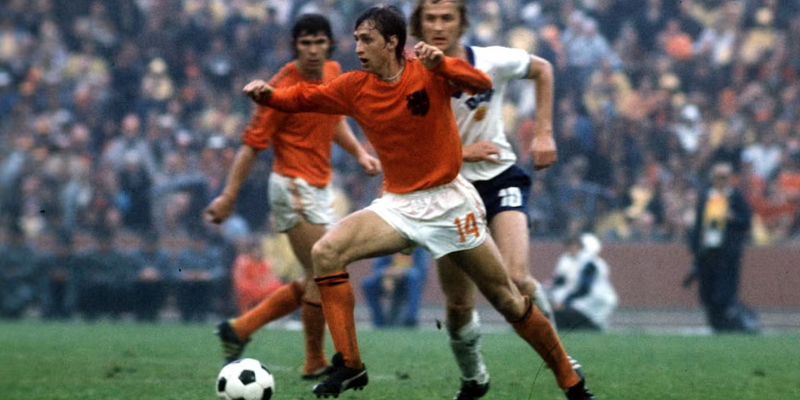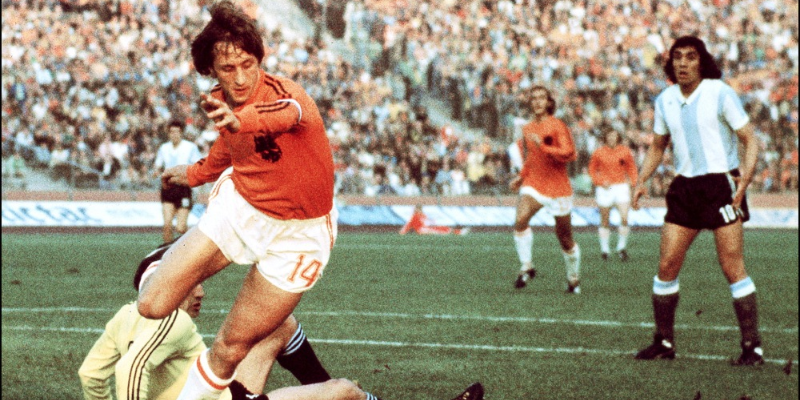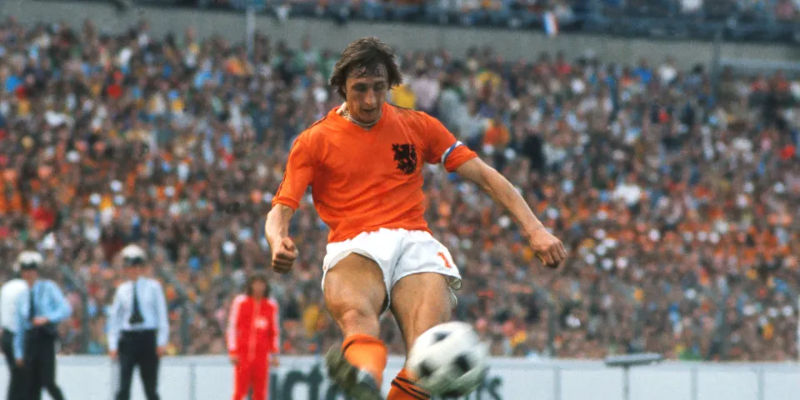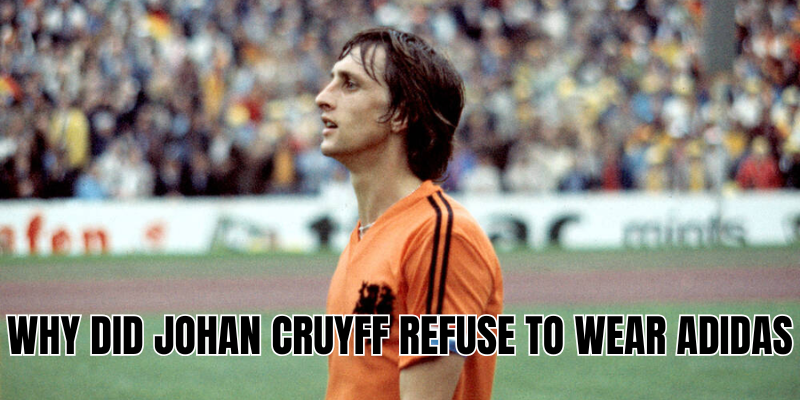In the summer of 1974, as the Netherlands dazzled the world with “Total Football,” one curious detail stood out in every team photo: Johan Cruyff—captain, leader, legend—wore an orange shirt with only two stripes instead of Adidas’s customary three. The question that haunts football trivia and sponsorship lore ever since is: why did Johan Cruyff refuse to wear Adidas as expected by his national federation? In this article, AnaGoal takes you behind the seam, into contract clauses, brand wars, and a personal rebellion that became emblematic of Cruyff’s indomitable spirit.
The Background: Cruyff, Puma, and the Dassler Divide

To understand this story, we need to travel back to the roots of sportswear rivalry. Adidas and Puma were not just competitors — they were born. He wore the Puma King boots, and by the early 1970s had signed a personal deal with the company. This contract carried a non-promotion clause: he was prohibited, or promoting rival brands in any public capacity that conflicted with Puma’s interests.
When the Dutch Football Association (KNVB) later struck a national kit sponsorship with Adidas—making Adidas the official supplier of the Netherlands team’s jerseys, shorts, and socks—a direct clash was inevitable. Cruyff’s loyalty to Puma meant he could not publicly display Adidas’s signature three stripes without violating his contract.
The Clash: Personal contract vs national kit deal
“The head sticking out of it is mine”
As the 1974 World Cup approached, KNVB expected the squad—including their captain—to wear the full Adidas kit with three stripes. Cruyff balked. He argued that though the uniform belonged to the federation, “the head sticking out of it is mine.” He insisted he would not wear a three-striped shirt.
Adidas threatened to withdraw support, and the Dutch FA believed they didn’t need to consult individual players. But Cruyff’s standing within the team and his commercial leverage forced negotiations. After tense discussions, a compromise was reached: Cruyff would receive a bespoke kit identical in style to that of his teammates—except with only two stripes on sleeves and shorts, carefully omitting one stripe to avoid Adidas branding, thereby neutralizing the conflict with Puma.
Brand reactions and marketing spin
From Puma’s side, this was a win. They capitalized on the narrative: their star man had rebelled against Adidas. Puma used it in their marketing, framing Cruyff as the anti-mainstream icon who refused to wear the forbidden stripes. On the Adidas side, reluctance to resist the national federation and the star player’s demands forced a grudging acceptance of a custom solution they never intended.
The result: in tournament photography, matchday prints, and broadcast footage, Cruyff’s shirt with two stripes became a symbol—not just of his status, but of athlete agency in the era before image rights became common currency in football.
What Happened On and After the Pitch

Cruyff’s on-field rebellion
In the 1974 World Cup, while his teammates sported the full three stripes, Cruyff’s uniform remained subtly defiant. He became a walking statement: the same orange shirt, same number 14, but with a deviation that fans, journalists, and rivals noticed. He went on to lead the Dutch into the final—where they lost 2–1 to West Germany—but his legend only grew.
The two-stripe shirt became a part of Cruyff lore: it wasn’t just fashion, it was a reflection of the man’s singular nature—independent, principled, outspoken.
Legacy and identity
Years later, when Cruyff launched clothing lines and authorized replicas, he insisted on preserving “his stripes.” He declared publicly that “two stripes belong to me… in combination with the number 14. They’re part of my identity.” He challenged Adidas in court when replicas appeared with three stripes, emphasizing that those two stripes were never Adidas’s—they were his.
Over time, the image of Cruyff in the two-striped orange shirt became iconic in its own right. It was reproduced in books, exhibitions, and tribute kits. The visual quiet rebellion resonated far beyond its origin in a sponsorship dispute.
Broader Significance: Contracts, image rights, athlete power

A turning point in athlete leverage
Cruyff’s defiance was more than a quirky footnote—it foreshadowed the growth of players’ image rights, individual endorsements, and collective bargaining. Here was a time before modern agencies, before FIFA rules on image rights, when a player on penalty of contract could force a federation to bend.
Today’s stars negotiate personal deals with clothing brands, limit kit usage, and even refuse national sponsors in extreme cases. But Cruyff’s two-stripe solution stands among the earliest high-profile instances of a footballer asserting commercial agency.
Brand wars and sports marketing lessons. Adidas could not bulldoze a national icon; Puma turned the narrative to its favor. The clash teaches modern marketers that athlete-brand alignment must respect both contractual obligation and individual identity.
Symbolism in football culture
In football culture, few images are as resonant as Cruyff charging in orange with his slender frame and minimal stripes. For fans, it illustrated that even on the biggest stage, the individual identity of a player could survive the commercial machinery. It became emblematic of Cruyff’s ethos: play your way, make your mark, bend conventions.
Final Thoughts
Why did Johan Cruyff refuse to wear Adidas? Because he already had a binding deal with Puma, and he believed his personal identity should not be compromised by a federation’s kit agreement. Those two stripes were his statement—subtle, radical, unignorable.
At AnaGoal, we believe this story reveals more than a historical quirk. It tells of a time when one of football’s greatest minds redefined the terms of loyalty, image, and power. As you dive deeper into football’s legends, controversies, and identities—stay with us., explore our other features: biographies of legends, iconic kits in history, or that time a star refused to wear the sponsor’s logo. You won’t want to miss what’s next.



